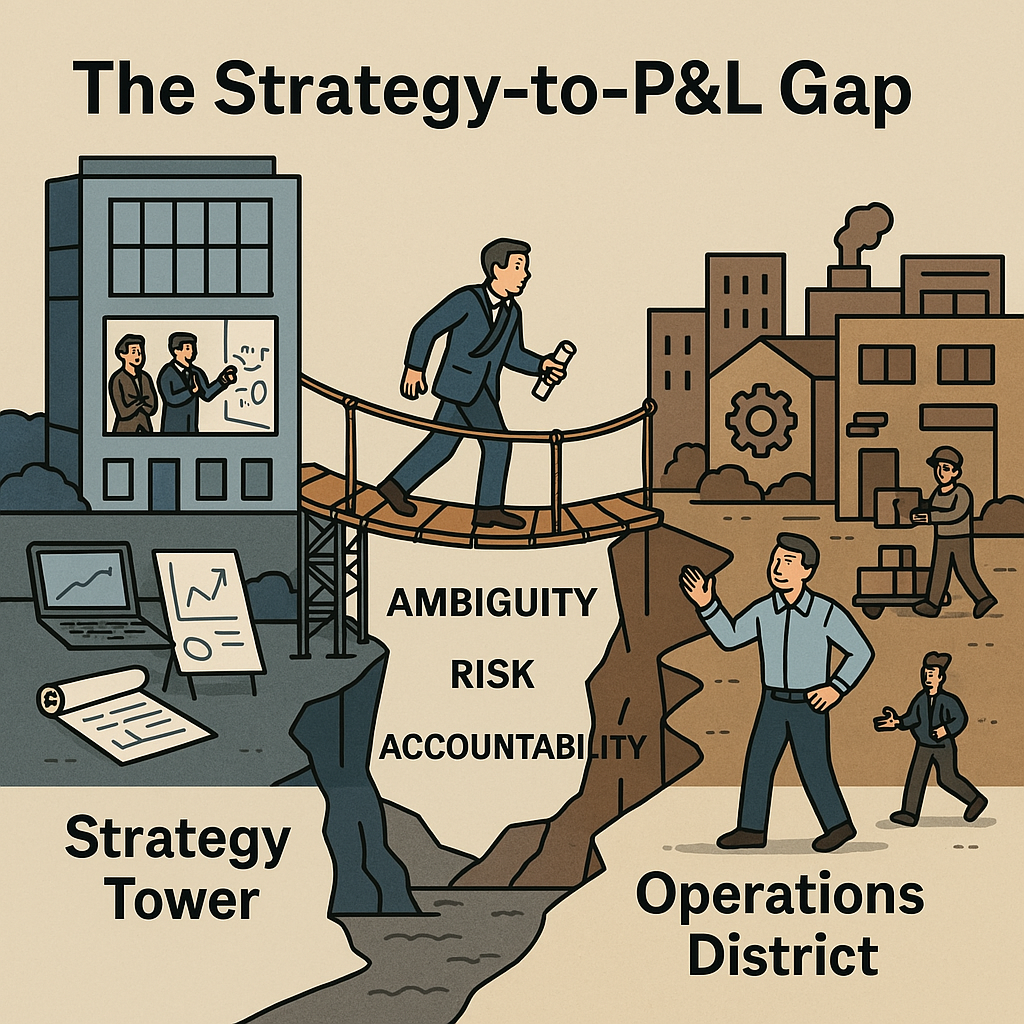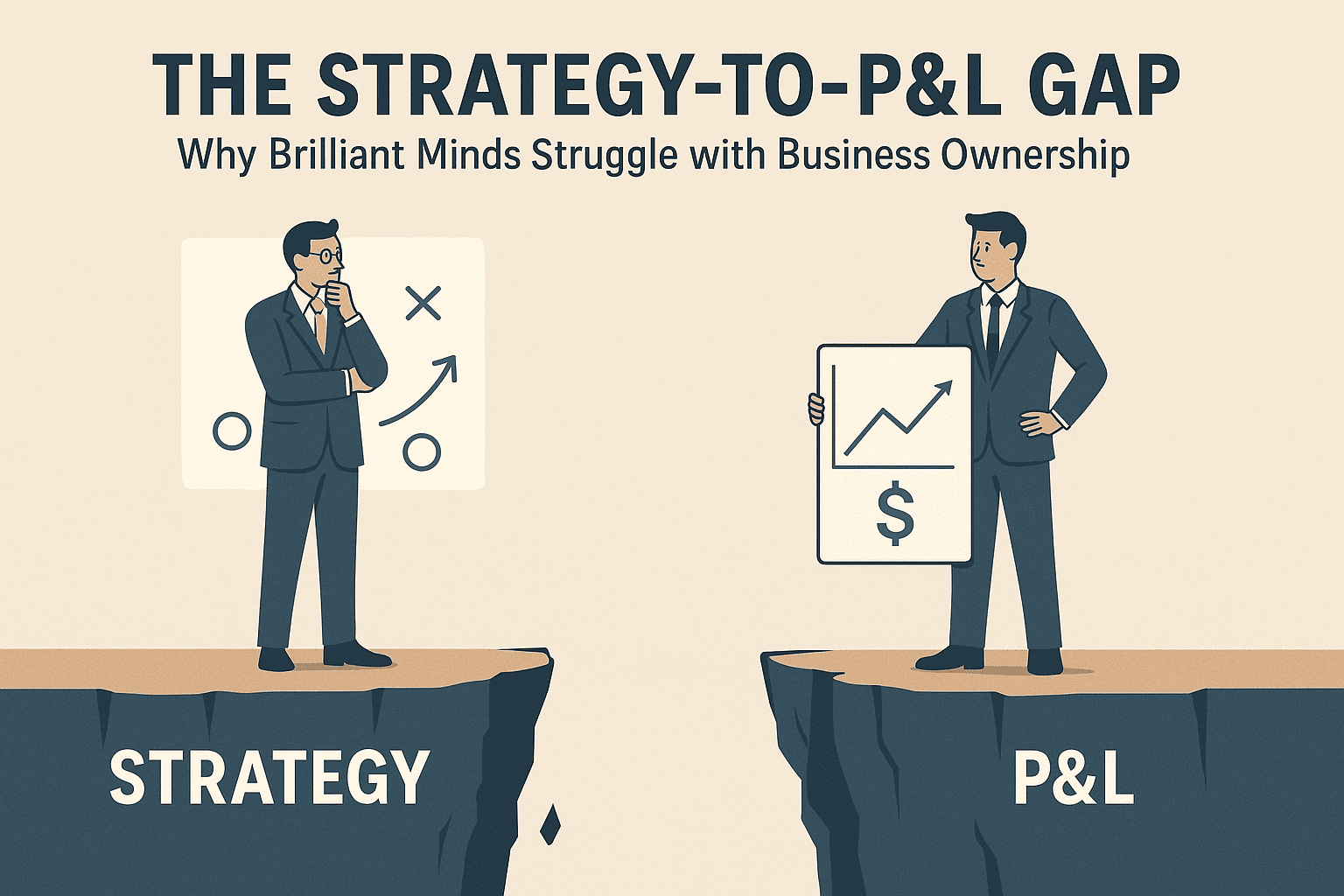In the corporate world, there’s a curious phenomenon that many have observed but few discuss openly: why do talented strategists and consultants often struggle when transitioning to roles with direct P&L (Profit and Loss) responsibility? In other words, how do we handle Strategy to P&L transition?
These individuals – analytical, logical, and often trusted advisors to the C-suite – seem perfectly positioned to take the helm of a business unit. Yet many remain stuck in advisory roles rather than stepping into positions where they’re directly accountable for business outcomes.
The Fundamental Differences
At its core, this challenge stems from several key differences between strategic advisory and operational leadership:

1. Ideas vs. Execution
Strategy roles excel at identifying opportunities and creating roadmaps for the future. However, P&L owners must live in the present reality while working toward that future state. They need to manage day-to-day operations while simultaneously implementing longer-term changes.
As one experienced business leader put it: “A P&L leader only focuses on results; it’s not so important how we get them – we just get them.”
2. Analysis vs. Action
Strategy professionals often pride themselves on thorough analysis, leaving no stone unturned before making recommendations. In contrast, successful P&L owners make decisions with limited information and adjust quickly as circumstances change.
The ability to act decisively without perfect information represents a significant mental shift for many strategists. They must learn to become comfortable with ambiguity and rapid course corrections.
3. Theoretical vs. Practical
Many strategists develop plans that work perfectly under ideal conditions – when priorities align, team members perform optimally, deadlines remain fixed, and no competitive surprises emerge. Unfortunately, business rarely operates under such perfect conditions.
P&L leaders must navigate complex organizational dynamics, manage competing priorities, and deliver results despite constant challenges. As one operational leader noted, “Everything works on a whiteboard. In practice, things often do not.”
The Skills Gap
Behind these differences lies a set of skills that strategists may need to develop:
People Leadership
P&L roles require strong people leadership abilities. While strategists may lead project teams temporarily, building and maintaining high-performing permanent teams requires different capabilities:
- Motivating diverse team members with varying skill levels
- Managing performance issues effectively
- Creating psychological safety while maintaining accountability
- Building trust across organizational boundaries
- Developing talent for the long term
Operational Know-How
Understanding the nitty-gritty details of how things actually work proves crucial for P&L leaders:
- Knowledge of operational constraints and bottlenecks
- Familiarity with systems and processes that drive results
- Understanding of implementation timelines and resource requirements
- Ability to identify and resolve execution issues quickly
Risk Management
Perhaps most importantly, P&L leaders must become comfortable with risk:
- Making decisions with incomplete information
- Taking personal accountability for outcomes
- Managing financial consequences of decisions
- Balancing short-term pressures with long-term goals
The Self-Awareness Challenge
Interestingly, many strategists lack awareness of these skill gaps. Having received consistent positive feedback throughout their careers based on their analytical abilities, they may struggle to recognize areas for growth.
This creates a paradox where the very success that propelled them forward now hinders further advancement. When faced with challenges in transitioning to P&L roles, they may attribute difficulties to external factors rather than identifying personal development needs.
Paths to Success
For strategists aspiring to P&L leadership, several approaches can help bridge the gap:
1. Seek Operational Experience
Look for opportunities to implement recommendations rather than simply delivering them. Experiencing the challenges of execution firsthand builds crucial operational muscles.
2. Focus on Results, Not Just Ideas
Shift your mindset from creating perfect plans to delivering measurable outcomes. Take ownership of results even when you don’t control all the variables.
3. Develop People Leadership Skills
Invest time in understanding what motivates different team members and how to build cohesive teams. Practice giving difficult feedback and managing performance issues.
4. Embrace Discomfort
Growth requires stepping outside your comfort zone. Be willing to make decisions without perfect information and learn from inevitable mistakes.
5. Find Operational Mentors
Connect with successful P&L leaders who can provide guidance on operational challenges and leadership approaches.
The Competitive Advantage
Strategists who successfully make this transition often become exceptionally effective leaders. Their ability to combine strategic thinking with operational execution creates a powerful leadership profile that can drive significant business results.
By understanding both the forest and the trees, these leaders can navigate complex business environments while maintaining clear direction. They balance short-term execution with long-term vision in ways that purely operational leaders sometimes struggle to achieve.
Conclusion
The journey from strategic advisor to P&L leader represents more than just a career move—it requires a fundamental shift in mindset, skills, and approach. By recognizing the differences between these roles and deliberately developing the capabilities needed for operational leadership, strategists can successfully bridge the gap.
For organizations, supporting this transition creates tremendous value. By helping strategic thinkers develop operational muscle, companies can build a powerful pipeline of well-rounded leaders equipped to drive results in an increasingly complex business environment.
What’s been your experience with this transition? Have you seen strategists successfully move into P&L roles, or have you made this transition yourself? Share your insights in the comments below.
For more leadership insights, subscribe to our YouTube channel at Leadership Paragon where we explore these topics in depth.
#leadership #careeradvice


Leave a Reply